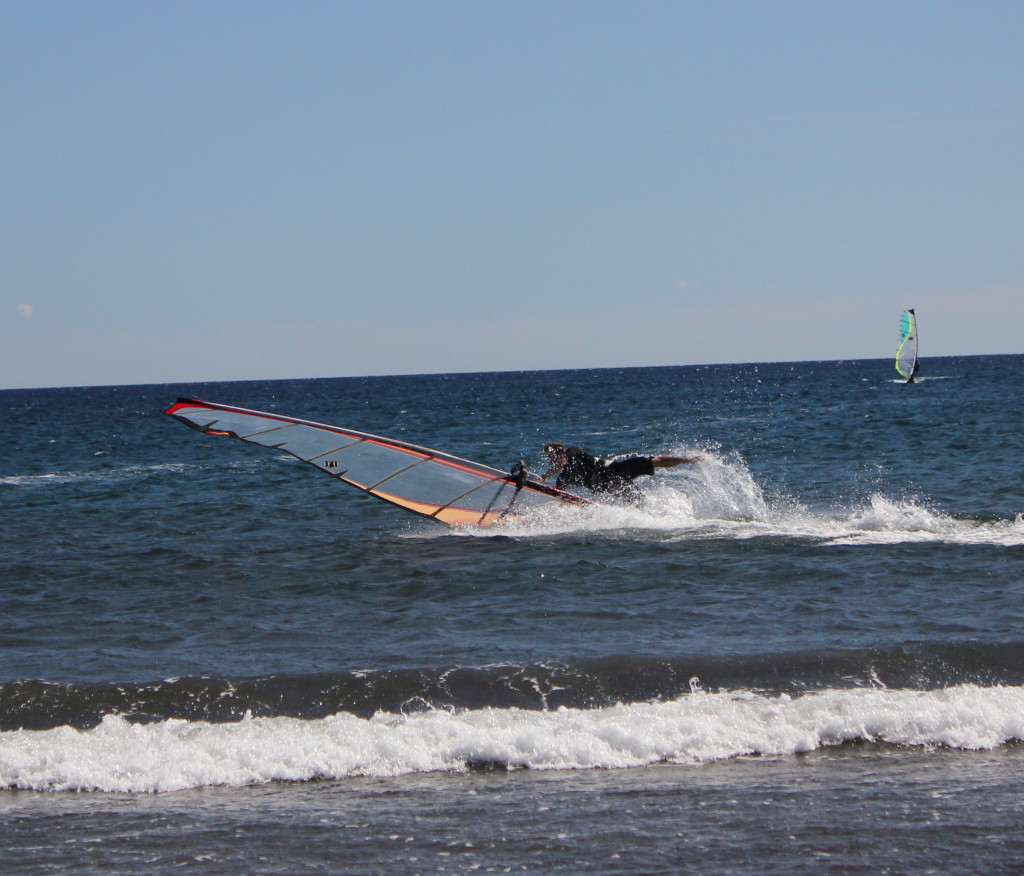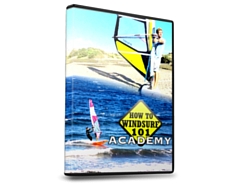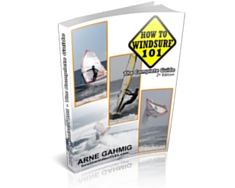Every windsurfer has had one, and it becomes the fear of every harness user, especially at the beginning. They can be painful and dangerous. If you don’t know what I am talking about, here is a video compilation showing us that it happens to the pros.
Now admittedly we won’t be having such extreme impacts since we are not going as fast or with as much power as these guys so I hope I haven’t scared anyone away from the sport.
I will first talk about how to avoid getting catapulted and then on the best reaction you can train yourself to do if you are already flying through the air.
Preventing the Catapult
There are a few alterations to our kit and body position that we can apply:
Learn to read the wind and waves
Most catapults come through being caught off guard by a gust or wave. Learning to read the wind changes on the water and the way the chop forms will help you massively to see what is coming at you.
Go down a sail size
I used to love sailing way to overpowered. To the point that if I didn’t do at least 2 catapults in one session I wasn’t satisfied. That phase has passed thankfully but it shows that a good way to reduce your likelihood of catapulting is to get good at planing with a smaller sail.
Long harness lines
If we have too short harness lines, the reaction time available to us when something changes unexpectedly is very small. With practice we become better and it becomes more comfortable to control the sail with short lines. Until then go for longer lines which give you a bit more leeway, more range to move the sail without moving your body and greater ease to hook out.
Smaller fin
Slalom sailers use big fins firstly to avoid spin outs from the massive sideways pressure but also to get lifted out of the water and have as little surface friction as possible. In other words, a long fin can make your board lift out of the water at high speeds (my beginner boards lift out when planing down a wave with the centre-board out). If we know how to control this there is no problem but since that probably isn’t the case, make sure your fin is not so big as to lift the board out of the water uncontrollably.
Have the foot in the back foot-strap
One of the main reasons that I recommend putting the back foot in the straps first is that this is the strap that avoids catapults more than anything else. Only having the front foot in the strap is useless as it is the pivot point over which we rotate in a catapult.
Pull the front arm close
As you notice you are being heaved forwards, pull the front arm in to take the power out of the sail. If you catch it early enough this will allow you to fall back backwards into the correct and stable position.
Push against the wind with the back hand
This can go in combination with the previous one, although I would only recommend it if you already have a little experience in lee-side sailing or some other form of sail control on the lee side of the sail.
Last Second Solution
At some point you will catapult. That’s just the way it is. Sooner or later you will be flung over the board and land with a crash or a splash. It is up to you and how you will react which one it will be and if the splash is going to hurt. The two things we want to avoid during a catapult is hitting the board with the mast or our body, and also avoid coming to a sudden halt on the sail (especially the mast).
The only real solution in this case is to sheet in as hard as we can and push the mast away from the wind. What this will do is make the sail turn downwind and let us rotate around with it so that we land in the water and ideally under the sail. This, incidendally, is also the second step to learning the front loop. I would recommend practicing this motion unhooked a few times so that you get a feeling for the motion and build up the reaction before you need it for real.
I hope this has been useful to help you prevent catapults. If you want to read more about them here is an interesting post on catapults.







I never read bigger bullshit specially about bacfoot in the strap! For your own sake please stop writing those articles!!!!!
Maybe it doesn’t work for you. It has worked for at least 70% of my students that try it in El Médano 🙂
Your articles are great !
They are always a pleasure to read, even for experts.
Thanks 🙂
Hey Pierre!
Thank you very much for the kind feedback! I really appreciate it 🙂
I agree with you 100%
Stop reading if you don’t like it. I like the articles even if I already surf for 25 years
CHeers Chrizzz. I’m glad you enjoy reading these articles 🙂
Back footstrap is the main thing that prevents you from being catapulted. His articles are great and help me improve a lot since i’m an intermidiate
I think you should add a section about fatigue and focusing. Because if you’ve been on the water for 2 hours long your body gets slower to react to the wind changes and the waves. Also the fatigue can make you loose focus and start thinking to something else and then BOOOM !
That’s the main cause I still get catapulted.
Hey Pierre! I have 🙂 Here it is 😉
http://howtowindsurf101.com/limit-time-water/
You are right. After 1 hour of sailing I start to make silly mistakes which due to lack of concentration because I am exhausted.
gd day to all ,intersting article i like it .specially the point with short lines ,two times happened to me ,in the same day within max 10min .the worst was tt i ve been blocked under the sale and hooked with the lines turn with the hook as my body made a loop before entering to the water and i was not able to unlash.trying to reach the mast to get a breath ,nothing.i stayed calm and fortunatelly i had the auto release harness and not the seat .i remember that it was very windy with gusts and i was trying to put the back foot strap –
Hi, thx for the article. Indeed my experience with my freestyleboard with footstraps close to the mastfoot is never put you front foot first. Certainly when wind is n’t stable. 🙂